The long period of infancy has been the one stabilizing influence in the foundation of human society. Around the mother and her helpless child is built the home which is the basis of all social systems. The cradle therefore has become a sacred emblem among civilized men. Even in primitive society the child is the strongest bond of family life. Both parents love their offspring with extreme passion and show their devotion and affection by solicitude and tender care for all their children but especially for the infant in the mother’s arms.

Image Number: 12928

Image Number: 12851
The cradle in Indian life is not something into which the child is placed to rest and sleep, but it is a device upon which he is bound for a large part of the first six months of his existence. It is more a baby carrier than a cradle, but it serves both purposes. The cradle, however, is not in universal use among the American Indians. The tropics are too hot and the arctic regions too cold for the comforts of the cradle. The Eskimo mother when on a journey tucks her baby away in the hood of her own great fur coat where it nestles against her warm back; while the mother in the tropics when on a journey places her naked baby in a hammocklike bandoleer made of bast or woven fibre, where it sits under the protection of her arm with its legs dangling against her own nude body.
Even where the cradle is in use the child is not confined all the time, as many suppose, but only when on a journey or while being carried about the house or field. In the house he is placed upon a fur robe or mat of some sort on the floor and allowed to roll about and exercise his growing limbs. At such times his sisters look after his entertainment and care. The tropical child, when not in his bandoleer, is placed in a hammock where he is free and safe from crawling insects. If his mother should wish to take him up and carry him about for a few minutes, she would allow him to sit astride her hip. This method is common also in other regions where the cradle is in regular use. Clothing is not allowed to hamper the freedom of primitive children until they are eight or ten years of age. Among some tribes a public celebration is held when a boy is invested with his first breechclout.
The great variety of cradle designs is due to, and depends upon, the available materials and the customs regarding the manufacture of other articles. There are dugout cradles, board cradles, bark cradles, skin cradles, basket cradles and hanging cradles. Each one the best possible type for its particular area. Besides the cradle framework, there is also the body of the cradle, the bed, the canopy, the ornamentation and the superstitious objects, all of which harmonize with the general culture of the tribe using them. In anticipation of the birth of a child, the father, with the strictest possible care, prepares the framework of the cradle which is to be its portable bed until it is able to walk. The bed, with all its ornaments of fringes, beads, quills, trinkets, bangles and feathers, is made by the grandmother who is an expert artist at such decoration. The fetishes and other superstitious objects may be attached later. A new cradle may be made for each new baby, but the more common custom is to preserve the cradle for successive infants, to treat it as a sacred object and to pass it on by inheritance to the next generation bearing notches cut in the framework to indicate the number of children it has accommodated.
When the average man thinks of an Indian he has in mind a Sioux in his buckskin shirt and war bonnet with a streamer of feathers reaching to the heels of his moccasins. And so, when he thinks of a papoose cradle, he thinks of the Sioux cradle made of two divergent slats held in place at head and foot by cross slats with the tops of the side slats extending a foot or more above the cradle sack. The papoose case of such a cradle is shoeshaped and stiffened around the head with a lining of buffalo leather. The case is covered with beautiful beadwork in geometric patterns of blue, red, yellow and green on a white ground. This cradle differs from all other types in that its sides are tied with four separate strings instead of being lashed together with thongs.

Image Number: 148784

Image Number: 12852
Skin cradles were common in the buffalo area of the Great Plains. The crudest type was a mere roll of buffalo skin having the fur on the inside. Better ones were made of dressed skins lashed to a latticework of flat sticks with a beaded or quilled canopy over the face. Among the Algonquian and Iroquoian tribes a board, beautifully carved and gorgeously painted, takes the place of the lattice frame of the Siouan cradle. To insure the life of the child, the board for the cradle is so selected that the heart of the tree is preserved and the head of the cradle follows the grain of the wood. The decorated bow of the canopy is bent at right angles while in all other types it is bent in a regular curve. These cradles also have a foot rest which is lacking in all others except in that of the bootjacklike frame of the Navajo.
In the interior of Alaska the Athapascan cradles are made of birch or cedar bark in the form of a trough having a hood and a bed of fur while along the North Pacific Coast the boatlike cradle is dug out of a cedar log. In the one region they make their utensils of bark and in the other they make them of wood. The Bellacoola make a coffinlike cradle of boards and furnish it with a be I of shredded bark overlaid with the softest fur. In another region away from the coast the Klamath use a forked stick for a framework across which sticks are tied for the attachment of the wickerwoven cradle. A variation of this type is found in the Pitt River region where a stick is bent in the middle, the two ends crossed and lashed together for the framework. The Mohave cradle is made like a trellis of sticks bent in the shape of an ox bow with crossbars lashed to the frame, upon which is placed the bed of willow bark. The Yaquis lay canes side by side and lash them with cross sticks to form the framework.
It is interesting to note that the oxbow type of cradle was found among the ancient Basketmakers and Cliffdwellers of the Southwest west and among the modern Apache and Hopi in the same general region. The Basketmakers, the earliest inhabitants of the cliff houses, had in addition to the stiff reedbacked cradle, two flexible types; one made of grass and yucca leaves with a woven yucca netting and another of woven strips of cedar bark held together by twined rows of yucca leaves. The Cliffdwellers cradle had the cross sticks lashed to the frame with cords made of human hair. The Apache cradle has the bent pole with laths of white pine, while the Hopi has the parallel rods attached to the curve of the bow. Twigs are then woven in this warp in regular basket fashion. On the Pacific Slope the dugout type of cradle is copied in coiled basketwork, whereas the Thompson River Indians made a beautiful shallow basket cradle of the same material used in their ordinary baskets. The canopy of most cradles was attached to the cradle in permanent form but a few tribes had a movable or adjustable top. The Luni were the only ones to have the folding or buggytop type. Their cradle board differed also from others in that it had a pillow rest of wood to steady the head. They used a soft bed to nullify the effect of the hard cradle.
The cradle, in addition to its ordinary use, was employed in some regions to produce aesthetic effects. The artificial deformation of the head to conform to an established ideal of beauty was accomplished by means of a special attachment to the cradle board. By means of this instrument continued pressure was applied to the head, while the bones were still soft, until the desired form was secured. The most common method was to flatten the forehead. In two distinct and widely separated districts, the Gulf States east of the Mississippi and the Columbia River region of Oregon and Washington the Indians attached a board to the cradle frame at such an angle that it produced the characteristic “flat head.”

Image Number: 148782
Intentional mechanical deformation of the head was common among ancient civilized peoples of the Old World and has been practiced among the American Indians from prehistoric to present times. Everywhere the Flathead cradleboard type is the most common but in some cases small boards, pads or bags of sand or seeds were used to produce the same general form. The frontal bone being thus compressed forces the head to expand laterally in compensation. Among some tribes of the Andes Mountains and in one place only in North America—Vancouver Island—pressure was applied about the head by means of bandages and a series of small pads passing over the brows and under the occiput, producing a long conical form with low frontal and narrow parietal regions.
Besides these intentional deformations there are others which are unintentionally produced and due to the form of the cradle-board. The result is as definite as it could be if intentionally produced. All mothers in the tribe use the same form of cradle, hence all children of the tribe have the resultant deformation. Thus a tribal mark is established but it may be so slight as to be unnoticed in the living head. The skull, however, would reveal the deformity and could easily be classified. Hence this accidental custom serves a valuable ethnic purpose. The most common deformity is the occipital flattening produced by long continued contact with the unpadded cradleboard. It is found throughout the Southwest tribes. Not all cradleboards produce this effect. The Algonquian tribes and many tribes of California and the Great Plains had perfectly normal heads and yet all of them used cradleboards of some sort. The Eskimo do not use a cradle and consequently their heads are normal.
The artificial deformation of the skull does not appear to produce any evil effect upon the health or the intellectual development of the child at the time or during his after life. The growing brain makes compensation by developing in the unobstructed directions until it has attained the normal dimensions.
Whatever the motive for intentional deformation may have been in the beginning the only motive today would seem to be the perpetuation of an ancient custom which is considered in the tribe as a mark of distinction. The form produced may no longer be considered an ideal one, nor the persons themselves considered superior men but the practice is continued out of respect for the ancestral custom. Like all customs which have lost their distinctive value and are performed perfunctorily this one tends to disuse and is destined to an early disappearance.

Image Number: 148781

Image Number: 148785
When an Indian infant dies during the time it is carried in the cradle, the grief of the mother is pathetic. Among some tribes the body is buried and the disconsolate mother fills the baby’s cradle with something suggestive of the child and carries it about with her wherever she goes for a year, giving it the same care as though the child were in it. When she is at work she stands the cradle against her wigwam and talks to it just as affectionately as if it were the child itself. In other tribes the cradle of the dead child is either thrown away, broken, burned, placed on the grave or buried with the corpse inside. The dead Apache baby is wrapped in its cradle and placed in the upper branches of a tall tree. If it were buried under stones as are adults, its soul would be too weak to come forth and rise to the spirit world.
The object of this article is not an exhaustive study of papoose cradles in general, but only an attempt to call attention to some of the types in our museum collections and more particularly to describe in some detail one very unusual and most remarkable object to which the name of cradle has been applied though it is in fact of unknown use. Whatever its use it is one of the finest pieces of basketry known anywhere.
A TRIUMPH OF BASKETMAKING
The basket was found by E.B. Wallace in a cliff house in Moki Canon, San Juan County, Utah, near the Colorado line. In 1904, it was exhibited at the World’s Fair, St. Louis, and was awarded a medal. Thereafter it was on loan at the Field Museum until finally purchased by the University Museum in 1908. It is in perfect condition and is certainly the finest example of the basketmaker’s art from that region in any museum.

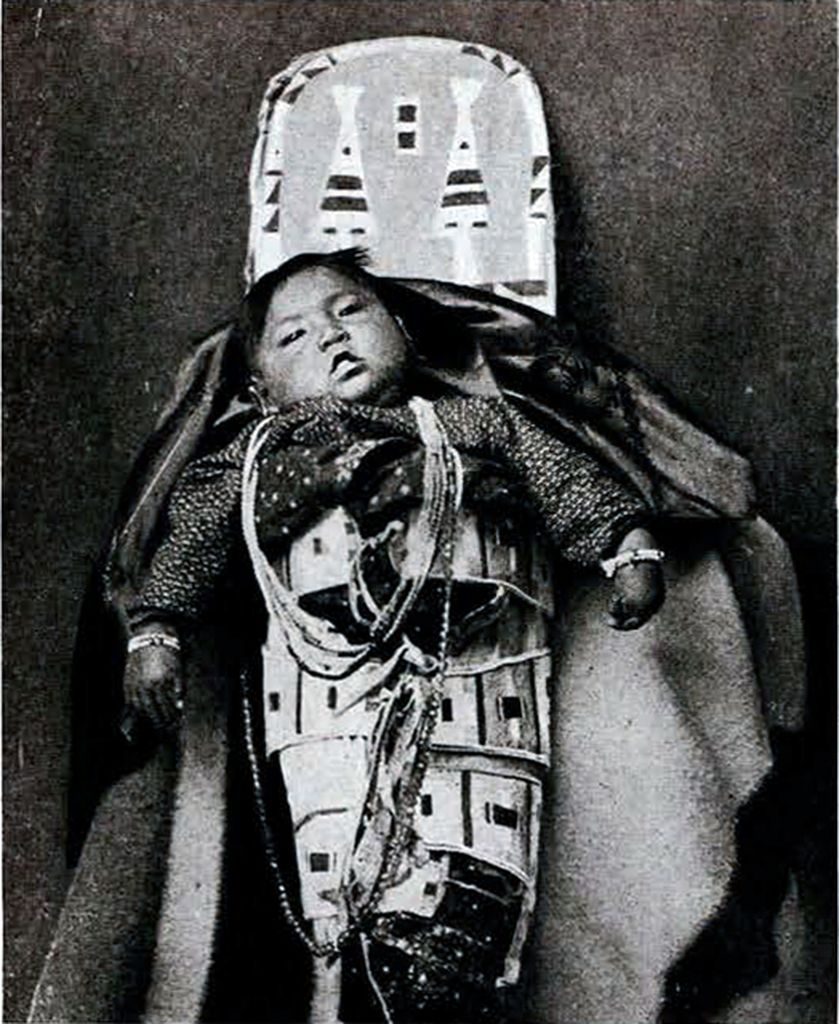
Since this specimen was found three others of the same type have been reported from nearby canons. Dr. J. W. Fewkes published one in Bulletin 50, 1911, Bureau of American Ethnology; Professor Byron Cummings published one in Bulletin of the University of Utah, 1910, and referred to another in American Anthropologist, Vol. 17, 1915 ; two unfinished bifurcated bottoms are in the Deseret Museum, Salt Lake City, Utah. None of these is in good condition.
The basket here illustrated is open at the top and continued into a bifurcated extension at the bottom. It stands 7¼ inches to the crotch and 22 I a inches in total height. The top diameters are and 6¾ inches while at the lower body they are 7 and 5 inches respectively. It is very ingeniously made of coiled basketry, four coils to the inch in the body with fourteen stitches to the inch. The splints are so narrow and are pulled so closely together that the foundation rods are completely hidden. The splints around the coils interlock with those immediately underneath. The coils of the body are made up of one large stick and one or more smaller ones on top for filling while in the leg coils there are six or eight split sticks one above the other. The coils are so strong that it would require a weight of two hundred pounds to crush the basket even at the top. Looking down into the basket the coils are seen to run counterclockwise.
The back of the basket where the thongs are attached shows some polish from use and the bottoms of the legs show considerable wear. On the inside there is some polish for four inches down from the top hut lower down the surface is very rough and shows no wear except on the crotch where apparently the burden, whatever it was, rested, as there is no evidence of wear in the bottoms of the legs. The thongs for support in carrying were 61a inches from the top. They remain on one side as two staples, having been cut off on the inside after the basket was last used. In a corresponding place on the other side of the back four holes remain where the thongs were fastened. Holes around the rim below the second coil about two inches apart would seem to indicate that the basket had been lined. There are also three pairs of holes in the front between the crotch and the middle zone of the design. These holes are so small that they The area in which these bifurcated baskets are found is restricted and corresponds very closely to that of the culture of the Basket-makers, the oldest culture of the cliff house region. So far, however, no baskets of such excellence have been found in what are known to be Basketmaker caves and besides there is a difference in the method of manufacture; the splints do not interlock in the oldest baskets but pass around the coil above and through one of the soft elements of the coil below. It would seem then that these baskets belong to the later Cliffdweller culture.

Image Number: 12894
The use of these baskets can only be conjectured. We have no complete account of how they were found or what was found in or about them. A pair of infant’s sandals was found with one of the baskets, but this is hardly sufficient evidence to prove their use. The basket is not at all suitable for a cradle. It is too small; a baby’s foot with a sandal on would not go into the leg of the basket and it would be most uncomfortable for the child even if it were possible to get him poked into it. All other types of cradles here observed are sensible devices made with reference to the proper care of the child. As already stated, the Cliffdwellers had the oxbow type of cradle in common use.
Basketry was very rare among the Cliffdwellers, hence what they had must have been made for some important purpose. The other baskets of this type which have been reported are almost exact duplicates of the one here figured. They were the most difficult of all baskets to make because of the legs and the strength required in the body. The legs must have been necessary in their use. Their presence, of course, is the reason they have been called cradles. We may take a suggestion from some of the tribes now living in the Southwest. The Hopi believe that a supernatural being, called Kachina, visits them during their sacred dances. They make wooden images of this being with short legs, a long body and a large head. They make also prayer offerings of two sticks with some object tied between them. These things are made by the medicine men of the different clans. In view of these beliefs and the practices of modern medicine men, it would seem reasonable to suppose that the ancients in the same region had somewhat similar customs and beliefs and that these bifurcated baskets belonged to medicine men who used them to carry sacred images of some sort.
W.C.F.

Image Number: 12808
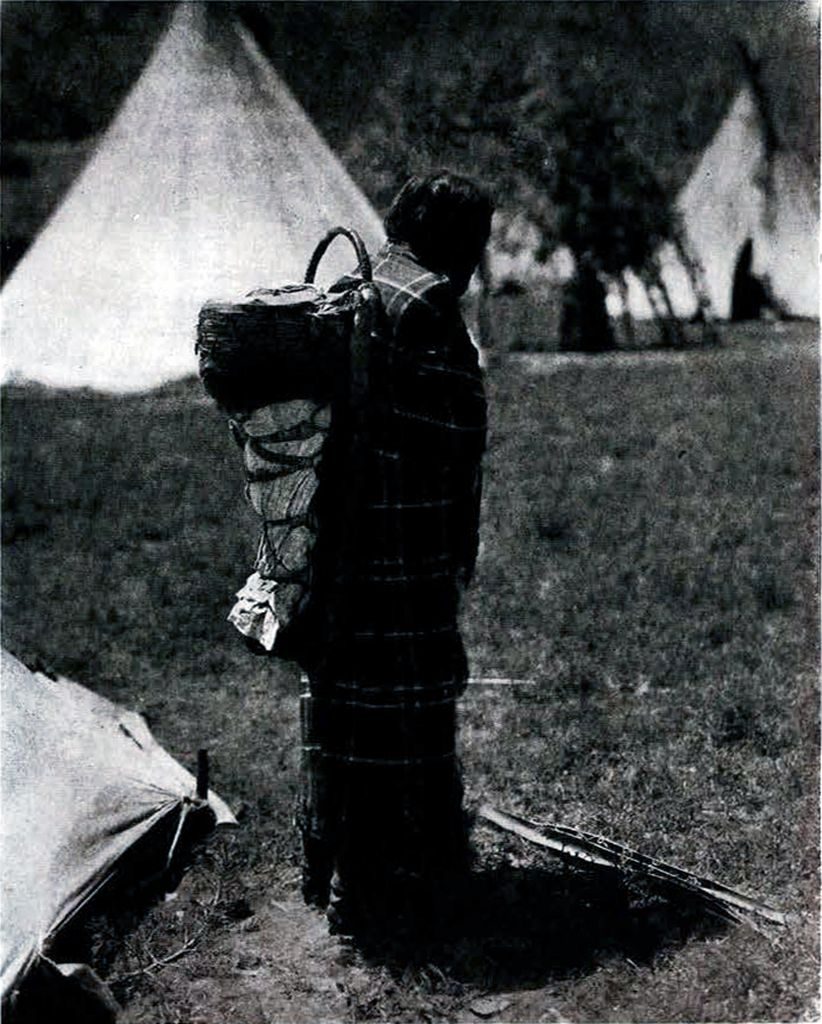
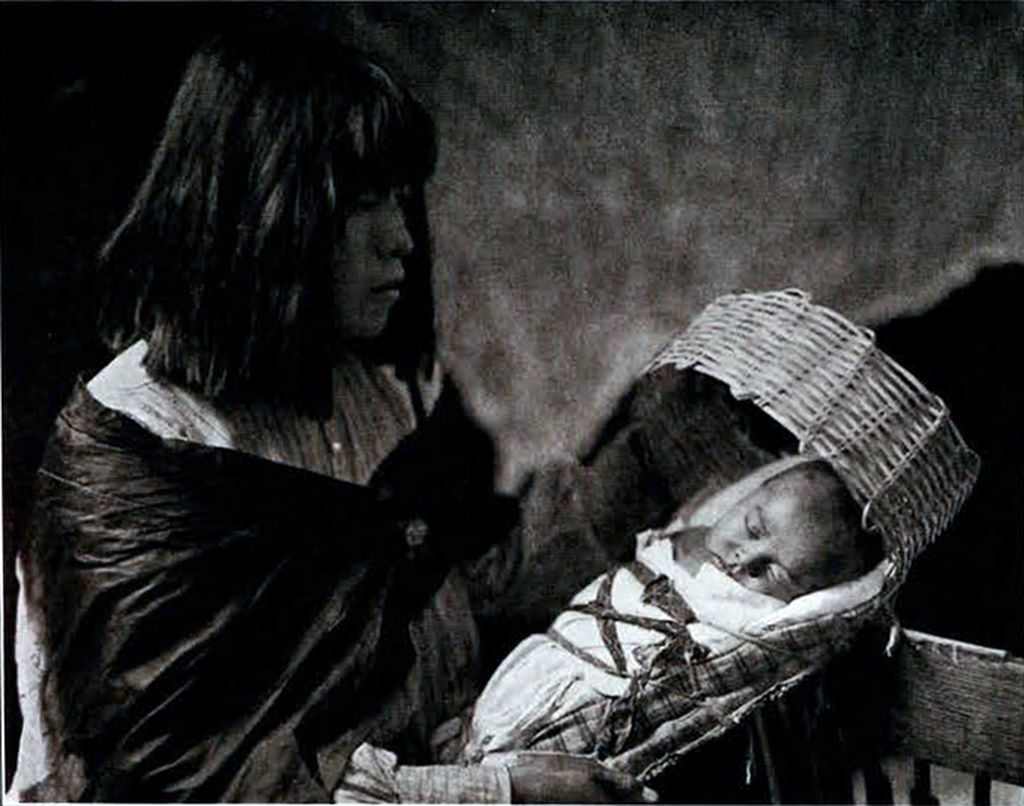
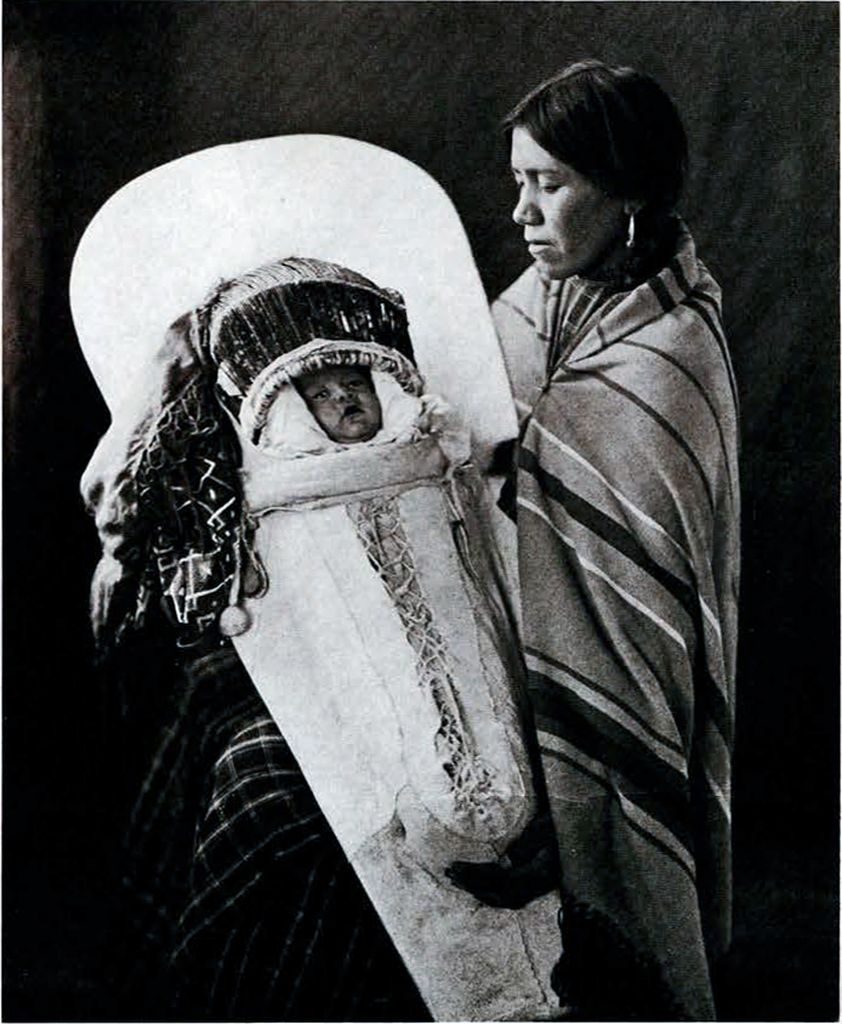
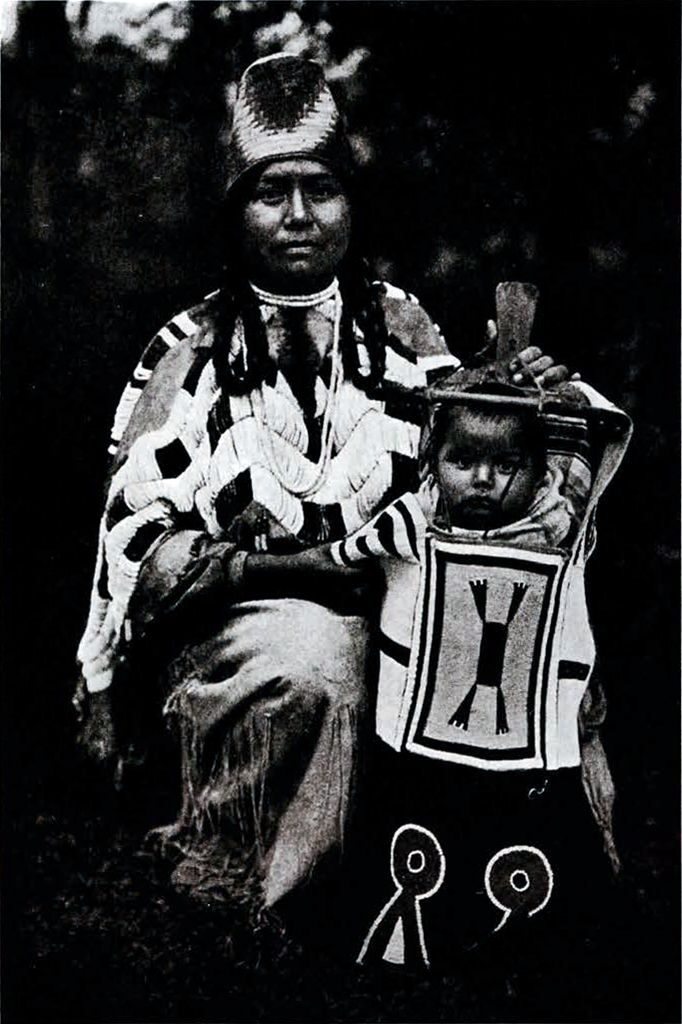
Image Number: 12750
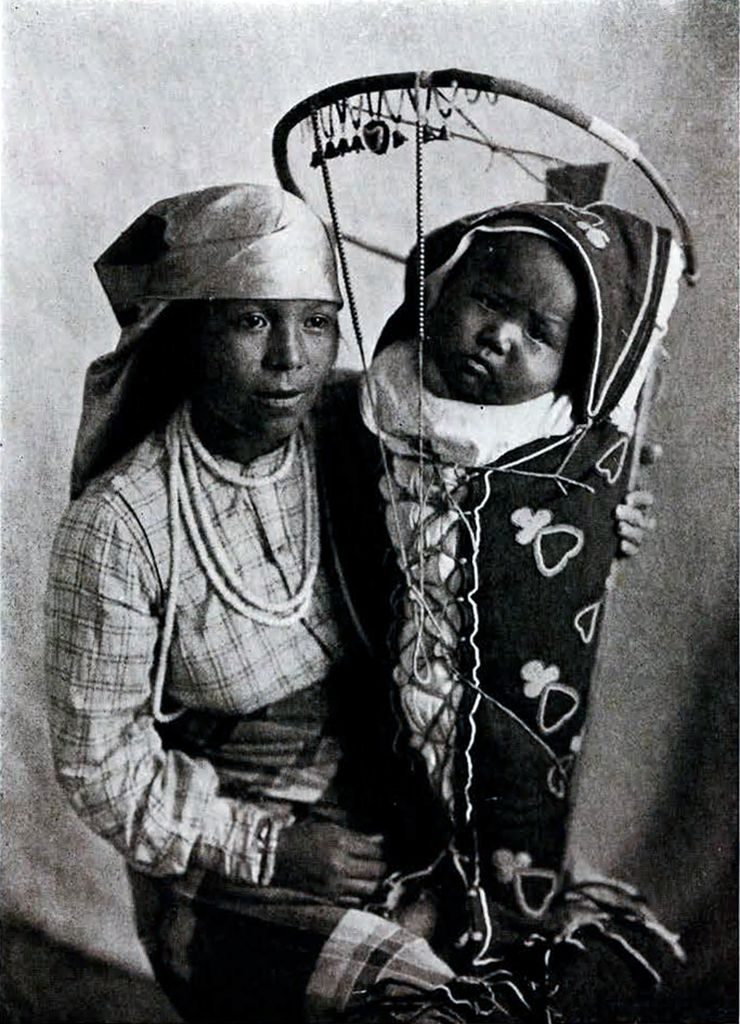

Image Number: 13117

Image Number: 12819



Image Number: 12820, 13516, 148783

Image Number: 12820


Image Number: 148786

